Barbara Sjoholm's Blog
November 16, 2025
Davvi Wind Farm Rejected in Northern Sápmi
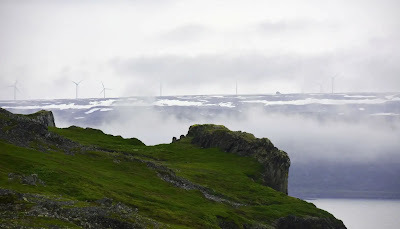 Raggovidda Wind Farm, Berlevåg, Norway
Raggovidda Wind Farm, Berlevåg, NorwayReuters reported on November 4, 2025 that Norway's energy regulator had rejected an application to build a wind farm in its northernmost county of Finnmark, citing impacts to a wilderness area as well as Indigenous Sámi culture.
The projected Davvi wind farm would have joined other wind farms in the northernmost region of Norway, such as Raggovidda, which has been operating since 2014 just south of the fishing port of Berlevåg. The landscapes of the plateaus in the north offer little resistance and the winds blow all year round with astonishing force, making the wind farm of Raggovidda one of the most efficient in the world, producing almost twice as much energy as an average farm.
However, the large farms come with a cost for the fragile biodiversity of the high north. Along with the turbines themselves come an entire infrastructure of roads, power lines, and buildings in areas once used only for reindeer herding.
The projected Davvi wind farm had been contested ever since its proposal some five years ago by a coalition that has included reindeer herders, political activists, and environmentalists. The Saami Council has strongly protested the giant industrial windpower development project, noting that it "would require an area equal to 8 000 football fields or 63 square kilometres and over 100 kilometres or service road networks." This would have been in a area of great natural beauty near Laksefjordvidda, near the sacred Sámi mountain of Rásttigáisá in the Tana and Lebesby municipalities, south of the Barents Sea and not far from the Finnish border.
 Rásttigáisá Mountain In their initial 2020 public response, the Saami Council also pointed out that:
Rásttigáisá Mountain In their initial 2020 public response, the Saami Council also pointed out that:"Little attention has been paid to the fact that the Davvi wind power plant is part of St1’s Power-to-X or hydrogen industrial plans in Kemi, Finland. St1 is planning to build a refinery which produces synthetic fuels from CO2 emissions of a pulp mill and windpower from the Davvi wind power plant. The project requires the building of new infrastructure, ie. a new powerline from Norway to Finland via the Sámi reindeer-herding cooperatives Galdoaivi ja Báišduottar. The powerline is included in the Lapland regional land use plan 2040."
I can't do better than quote at length from a statement produced in 2020 by the Friends of the Earth Norway, criticizing the application by the corporation Grenselandet AS:
"The planning area for Davvi wind power farm is in Laksefjordvidda, one of the largest areas without major interventions in Norway. This arctic nature is undisturbed by industry and buildings, and one can walk for days surrounded only by nature, a totally unique experience. There are very few such areas left in Norway. The Intergovernmental Panel on Climate Change (IPCC) reported in August that almost three-quarters of the world's ice-free land is affected by human activities, and the remaining proportion is shrinking rapidly. Such large intact nature areas are thus very valuable and important to preserve - both for the outdoor experience and for nature's intrinsic value. Building hundreds of wind turbines with associated roads and construction sites in an area the size of Stavanger will for the foreseeable future destroy the priceless nature of Laksefjordvidda.
"The area is very poorly mapped for biodiversity. However, we know that the Arctic is an important ecosystem. At first glance the area may seem like deserted stone rubble, but it is in fact the habitat for a number of species, several of them on the red list for threatened species. Here lives the rock ptarmigan, which is a bird species that Norway has an international responsibility to protect, and tiny beautiful flowers grow close to the ground. In the summer of 2016, a nesting of the critically endangered lesser white-fronted goose was discovered just over three miles from the plan area. Birds of prey such as ravens and snowy owls hunt for the lemmings and other small rodents. This area is an important route for Arctic foxes wandering between Varanger and Nord-Troms. To get a good overview of the diversity of species there is a need for thorough survey and field work, but we already know that the Arctic landscape is richer and more impressive than one might at first assume.
"In addition to the great natural and landscape values, the area is very important for the Sami indigenous people. The sacred mountain Rásttigáisá is located in the immediate vicinity of the planning area for the wind farm, and construction will be very negative for the reindeer resources. The rocky mountain peaks are also important for the reindeer, as a refuge from troublesome insects. Reindeer herding is already under severe pressure from a number of developments, and this burden will soon make it impossible for the next generation to continue the traditional way of life."
October 16, 2025
Sámi Folktales from the Near and Far Worlds
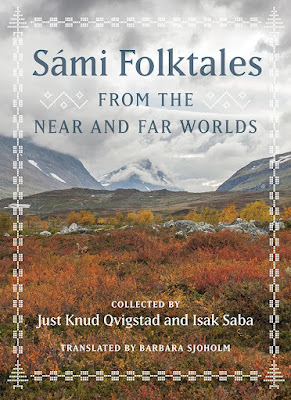 I'm thrilled to present the cover of my next book, Sámi Folktales from the Near and Far Worlds, the most extensive compilation of Sámi narratives recorded from Sámi storytellers ever published in English translation.
I'm thrilled to present the cover of my next book, Sámi Folktales from the Near and Far Worlds, the most extensive compilation of Sámi narratives recorded from Sámi storytellers ever published in English translation. Although the publication date is some months away--April 28, 2026 to be exact--it's now in the catalog on the University of Minnesota Press website. I love how the photograph captures the sense of mystery and spaciousness of Finnmark in Northern Norway/Sápmi, where the narratives were collected in the late 19th and early 20th centuries.
I'm also really pleased to see Isak Saba's name on the coveras a second collector. When the initial volumes of these folktales werepublished in the bilingual Norwegian Sámi edition in 1927-1929, onlythe name of Just Knud Qvigstad, the eminent linguist and folklorist, waslisted. Isak Saba, a teacher, politician, and folklorist, was relegated to arole as a contributor, particularly of stories from East Finnmark.
But my research showed that Isak Saba had also been a collector and translator of Sámi folklore. Only his untimely death kept him from publishing his own works of narratives by Skolt and Varanger Sámi storytellers, fifty of which are included in this book.
Here are a few things that early readers have said about this edition of three hundred narratives, translated from the Norwegian:
“Beautifully written, the introduction to Sámi Folktales from the Near and Far Worlds captivates the reader from the very beginning with poetic descriptions of the Sámi landscape, the historical context and thematic characteristics of the storytelling tradition in Sápmi, and an exploration of the relationship between Just Knud Qvigstad and Isak Saba. This book is a valuable collection of Sámi stories.” —Line Esborg, Head of Norwegian Folklore Archives, University of Oslo
“For decades, these stories have provided contemporary Sámi literature with drama, detail, and inspiration. This collection is a treasure trove for every writer and reader to choose from, and it's a gift to the English language that these folktales are now translated.” —Elin Anna Labba, author of The Rocks Will Echo Our Sorrow: The Forced Displacement of the Northern Sámi
“Sámi Folktales from the Near and Far Worlds is invaluable to anyone even remotely curious about the Sámi. The deeper you dig into this collection, the more satisfying it gets. Often mysterious and magical, sometimes scary, occasionally funny, the tales are always captivating. They are told with an immediacy and sense of the storyteller’s voice that does more than entertain, it passes on insights into Sámi culture not readily found anywhere else. Including extensive historical information, translator Barbara Sjoholm’s introduction is worth its weight in gold.” —Lise Lunge-Larsen, author of Seven Ways to Trick a Troll
October 3, 2025
The Reindeer of Chinese Gardens, Reading at Village Books in Bellingham Oct 12, 4 PM
 A heads up for anyone living north of Seattle: I'll be reading from my historical novel, The Reindeer of Chinese Gardens, at the fantastic Village Books in Bellingham's Fairhaven district on Sunday, October 12, 2025, at 4:00 PM. Details here.
A heads up for anyone living north of Seattle: I'll be reading from my historical novel, The Reindeer of Chinese Gardens, at the fantastic Village Books in Bellingham's Fairhaven district on Sunday, October 12, 2025, at 4:00 PM. Details here.The novel has been out since February, and I've done a number of events in person and online, as well as interviews on radio and book clubs on Zoom. Unsurprisingly, since a good portion of the novel is set in Port Townsend, it's been very popular with locals and there's always a waiting list to read at our library. I'm still having interesting conversations with people about things they didn't know about Port Townsend, including the existence of a large and thriving population of Chinese who lived here in the last decades of the nineteenth century. I also get asked which house Dagny Bergland, the narrator of the story, lived in (the house is invented but some of the Victorian homes on Morgan Hill with a view of Admiralty Strait were inspirations). Although parts of the novel also take place in Seattle, Alaska, and Norway, it's the Port Townsend settings that really seem to stir the most interest. "I can see Dagny and Edward on Lawrence Street," they tell me. It's a wonderful feeling when I hear that readers can visualize the bustling wharves on Water Street and the more refined churches and shops in Uptown and see my characters walking past them!
I've also had the chance to hear from Sámi-Americans about their family experiences of immigration to the US. One memorable event took place at the Nordic Museum in Seattle, where I spoke with Amy Swanson King, herself a descendant of Sámi immigrants and an active member of the Pacific Sámi Searvi in the Northwest. I've been happy to contribute to a stronger sense of this historic and contemporary community.
See you in Bellingham!
September 22, 2025
Conflicts around Mining in the High North of Norway and Sweden
The Barents Observer has just published another deeply-reported article on conflicts between the Scandinavian states and mining interests in the north of Sweden and Norway and environmental groups and Sámi reindeer herders, as well as other concerned citizens who live in those areas.
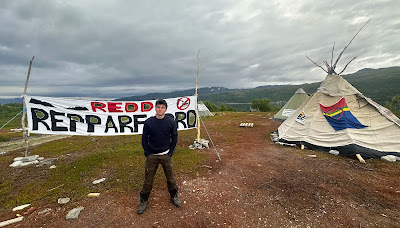
The journalists focus particularly on the strongly opposed Nussir Copper Mine near the Repparfjord in Norway and the Per Geijer deposit in Kiruna, near the current iron ore mines run by LKAB. The new deposit is projected to supply Europe with not just ore but rare earth elements. Many already know that the city of Kiruna was forced to move from its historic site by the LKAB mine. Further mining may well cause another move, as well as impacting the grazing lands traditionally held by the Gabna siida's reindeer herds.
September 9, 2025
Britta Marakatt-Labba's Ancient Mother Statue on the Highline
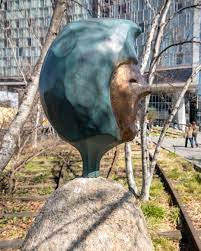 Urmodern, by Britta Marakatt-Labba
Urmodern, by Britta Marakatt-LabbaFor anyone in New York on Oct 7 at 12:30-1:30, the Sámi artist Britta Marakatt-Labba will be discussing her sculpture, Urmodern, located on the High Line between Gansevoort and Little West 12th Streets.
Many of us know Marakatt-Labba through her embroidered narratives of Sámi history and other two-dimensional work. Her reknown has only increased over the last years, with one-person shows at the National Gallery in Oslo (2024) and the Moderna Museet in Stockholm (2025), and she's also been represented in art exhibits in the U.S., in connection with other Arctic and Sámi artists.
I only recently heard that she has a sculpture on the Highline in New York, at least until March of 2026, and that it is meant to represent a female deity. Here's the text from the announcement for her talk:
"For the High Line, Marakatt-Labba presents Urmodern, which translates to “primordial mother.” Sámi mythology is based on the belief that every stone, plant, and body of water has its own spirit. It teaches that the cosmos and the earth were created and are protected by goddesses, emphasizing the pivotal role of women in Sámi culture. Through this lens, Urmodern serves as a representation of these female deities. The boulder-like base of the work is made of granite, topped with the head of the goddess rendered in bronze. Marakatt-Labba’s contribution to the High Line underscores the importance of environmental stewardship on a global stage, engaging audiences in critical dialogues about Indigenous rights and feminism."

September 7, 2025
Katarina Barruk at the BBC Proms
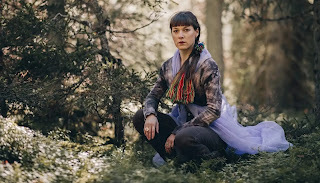 Katarina Barruk, 2025On August 31, 2025 Sámi vocal artist Katarina Barruk performedin concert with the Norwegian Chamber Orchestra at the BBC Proms festival atLondon's Royal Albert Hall. It was a history-making event, given that she wasthe first Sámi performer ever to participate in the Proms. I read about this inthe BarentsObserver, which has a link to a broadcast from Radio Sweden, where she’sinterviewed (in English). Barruk’s Sámi identity wasn’t the only thing notable aboutthe event. Barruk sings and joiks in the Ume Sámi language, which is consideredextinct in Norway and is severely endangered in Sweden. It was traditionallyspoken around the Ume River in central Sweden, around towns such as Sorsele, Lycksele,Arvidsjaur, and Storuman, where Katarina Barruk was raised. Her father, one ofonly a handful of people to still speak Ume Sámi, is a language consultant andteacher whose work involves documenting and rivitalizing thelanguage; in 2018 he published the first Ume Sámi-Swedish dictionary.
Katarina Barruk, 2025On August 31, 2025 Sámi vocal artist Katarina Barruk performedin concert with the Norwegian Chamber Orchestra at the BBC Proms festival atLondon's Royal Albert Hall. It was a history-making event, given that she wasthe first Sámi performer ever to participate in the Proms. I read about this inthe BarentsObserver, which has a link to a broadcast from Radio Sweden, where she’sinterviewed (in English). Barruk’s Sámi identity wasn’t the only thing notable aboutthe event. Barruk sings and joiks in the Ume Sámi language, which is consideredextinct in Norway and is severely endangered in Sweden. It was traditionallyspoken around the Ume River in central Sweden, around towns such as Sorsele, Lycksele,Arvidsjaur, and Storuman, where Katarina Barruk was raised. Her father, one ofonly a handful of people to still speak Ume Sámi, is a language consultant andteacher whose work involves documenting and rivitalizing thelanguage; in 2018 he published the first Ume Sámi-Swedish dictionary. Katarina Barruk herself has been a language-immersionteacher as well as a musician; now she mainly concentrates on her work as asinger, appearing internationally and releasing videos and singles. Like anotherSámi vocalist and activist, SaraAjnakk, who I’ve written about before on this blog and who did not grow upspeaking Ume Sámi but has painstakingly learned it and who writes many of hersongs in it, Barruk has become a spokesperson for Ume Sámi. Much of thecoverage of Barruk’s performance at the Proms mentioned the Ume language.
It wasn’t the first time that Ume Sámi was in the news in England—Iwas able to find an article in the Guardian from 2014, “Reindeerherders, an app and the fight to save a language,” which gives a goodoverview of the language and the efforts to revitalize it. In the article, Katarinais mentioned as a “young, passionate advocate for access to language education,”who is “currently recording her first album using Ume Sami lyrics andinfluences from the traditional Sami Yoik.”
August 25, 2025
Sámi Connections with Polar Expeditions
It’s been very warm here on theOlympic Peninsula in the Pacific Northwest the last week. Not compared to Phoenix,of course, but high for those of us more used to summer temperatures in the sixtiesand low seventies. The heat encourages me to continue on with polar themes.
Recently,for my travel book North Coast of the North, about Arctic Norway, I’vebeen doing some research into a handful of Sámi from Northern Norway whoaccompanied some of the famous polar explorers on expeditions to Svalbard, Greenlandand Antarctic. A good source has been the website, Polar History, sponsored by the Polar Institute and the Arctic University in Tromsø.
Along withbiographies of over two hundred men, including six Sámi, is a separate category listing twenty-eightwomen who had a connection to one or both of the poles, whether as cook, wife,hunter, scientist, or explorer. One woman appears in both categories.
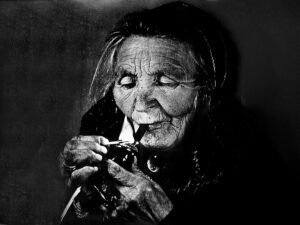 Margarthe KittiThis is Margarthe(Lango) Kitti. As a young girl from a reindeer herding family outside Tromsø, Kittiwas approached for her skill in sewing and commissioned to create theSami-style gákti, fur and skin clothing and shoes, for Roald Amundsen’s GjøaExpedition through the Northwest Passage.
Margarthe KittiThis is Margarthe(Lango) Kitti. As a young girl from a reindeer herding family outside Tromsø, Kittiwas approached for her skill in sewing and commissioned to create theSami-style gákti, fur and skin clothing and shoes, for Roald Amundsen’s GjøaExpedition through the Northwest Passage. The idea ofemploying Sámi men, known for their abilities as skiers, on expeditions to thefrozen ends of the earth seems to have originated with Adolf Erik Nordenskiöld,who participated in three geological trips to Svalbard. On one such expeditionin 1872, he purchased forty reindeer and hired four Sámi men to take care ofthem, only one of whom is named: Nils Mathisen Sara. After Nordenskiöld’ssuccessful transit of the Northeast Passage, he set his sights on Greenland. In1883, Nordenskiöld recruited two hardy Sámi men, Pava Lars Tuorda and AndersRassa, to sail with him and his team of scientists to the west coast ofGreenland and from there see if they could cross overland to the east coast.
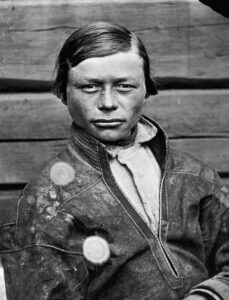 Pava Lars Tuorda
Pava Lars TuordaPava Lars Tuorda wasborn in the Tuorpan siida, in the mountains west of Jokkmokk, Sweden in1847. He early showed himself to be a skier of great endurance and an excellenthunter of wolves and bears, with spear and rifle. In the 1860s he was hired asa guide for Swedish geographers who were in the process of mapping areas ofNorrbotten province. In addition to bearing large loads, Tuorda was adept atfinding routes through challenging terrains. Asked for other recommendations,Tuorda suggested his neighbor Anders Rassa. The two men sailed off in the Sophiefrom Göteborg with the rest of Nordenskiöld’s team in June 1883 for the westcoast of Greenland.
One ofNordenskiöld’s theories was that he might discover a warmer center to theworld’s largest island, where trees and other vegetation could conceivablythrive in a drier climate away from the coast. But the team, burdened with amassive amount of equipment, found it difficult to navigate their sledgesacross Greenland’s glacial fissures and the deep snow that hid wet pocketsunderneath. Tuorda took the lead, but eventually Nordenskiöld decided thesledges could no longer go on. Instead, he sent Tuorda and Rassa ahead. Withtwo compasses, a barometer, and a pocket watch, they were to ski as far as theycould inland. Tuorda also took his bear spear. In the next fifty-two hours thetwo Sámi skied east 143 miles and then turned around and skied back, restingonly two hours during that time, when they were enveloped in a snowstorm andhad to dig themselves into the snow until it passed. They found no grass ortrees, only endless vistas of ice and snow.
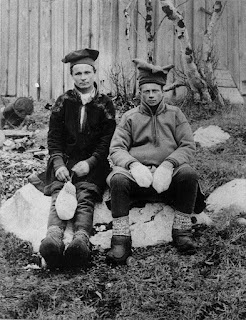 Per Saivo (l.) and Ole Must,1898
Per Saivo (l.) and Ole Must,1898 Anotherpair of Sámi men who participated in Arctic exploration were Ole Must and PerSaivo from Kirkenes. Thesetwo young men had their photographs taken by Elissif Wessel before they leftfor the South Pole on the British Antarctic Expedition 1898-1900, headed by theNorwegian-British leader, Carsten Borchgrevink, and with the aim of collectingscientific data, including fixing the location of magnetic south pole, and thenadvancing as far as possible towards the pole itself. The expedition’s crew,almost all Norwegian, successfully spent the winter of 1899 in twoprefabricated houses on the Antarctic mainland and managed to get by sledge to78° 50′ S., setting the “farthest south” record of the time.
August 4, 2025
Queering Polar History in Tromsø
Queering Polar History, an exhibit at the Polar Museum in Tromsø, just ended this past June. Sadly, I only became aware of it recently, though I was in Tromsø twice during the three years it was on. My focus in Tromsø both times was library research on Sámi folktales, and I didn’t have much time to revisit museums I’d already been to over the years. I also recalled the Polar Museum, in a remodeled wooden warehouse down on one of the city wharves, as being a little too taxidermic for my taste.
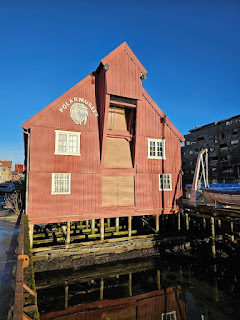
But on October 7, 2022, a temporary exhibit opened in connection with Norway’s Queer Culture Year, a joint initiative from the Queer Archive at the University of Bergen, the Norwegian National Museum, and the Norwegian National Library. This was to mark the 50th anniversary of the decriminalization of male homosexuality in Norway. The repeal of section 213 of the Norwegian Penal Code marked the beginning of a greater openness about gay life, literature, and activism, which would transform Norwegian society in the coming years.
The Polar Museum is in many ways an unlikely venue for a thematic exploration of gender and sexuality in Northern Norway and the polar regions, particularly the Arctic. Due to the preponderance of male explorers, polar exploration has usually been associated with a certain kind of obsessive, fur-clad hypermasculinity, exemplified by Norwegians Fridtjof Nansen and Roald Amundsen and the many other men who participated in various late nineteenth and twentieth century races to the poles.

Curators and cultural studies researchers at the Polar Museum, Silje Gaupseth and Marit Anne Hauan, decided to take another look at material the museum might already have in its archives and at other newspaper clippings, fiction, artifacts, and urban legends suggested by external contributors with a knowledge of queer history. The result was an expanded look—in the exhibit itself and in a large format booklet with seven articles and an interview accompanying the exhibit—at the many dimensions of queer history.
One of the more intriguing articles focuses on a photograph from the Norwegian South Pole Expedition of 1910-12. It was snapped on the famous Fram, captained by Roald Amundsen, as the ship crossed the equator on December 14, 1910, en route to the South Pole. A celebration is in progress among the crew. A bit surprisingly, it includes what seems to be a woman in a short white costume, sitting on the lap of a crew member, with one arm around his neck and the other hand stroking his cheek. Second mate Hjalmar Fredrik Gertsen had, with the help of the ship’s sailmaker, had spent the day transforming himself into a ballerina, writing later that “I was extremely cute...and I was flirted with a lot.”
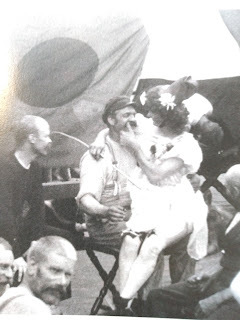 "The Equator Party," Fram 1910
"The Equator Party," Fram 1910In her fascinating article about this photograph, “A Few Square Metres of Leeway,” Gaupseth delves into the Anglo-American tradition of cross-dressing or “polar drag” aboard ship during performances, perhaps as a way of providing “a safe outlet for sexual tensions between the men on the expedition.” British officers had often been educated at schools where cross-dressing was encouraged in student theaters. After around 1920, such playful acting became more stigmatized as homosexual expression, but in 1910 it was alive and well on the Fram.
I was also captivated by Marit Anne Hauan’s article, “The Walrus—behavior among Arctic marine mammals that breaks the norms.” I mean, with a title like that, who wouldn’t wonder about what walruses are getting up to? Plenty, as it turns out. The Arctic walrus lives along the eastern coast of Greenland, and on the archipelagos of Svalbard and Franz Josef Land, and east along the Barents and Kara Sea. These large and magnificent animals, as well as their brethren, the Pacific walrus up in Alaska, were hunted almost to extinction.
Walruses are very social animals, as you can notice in the wild and in documentary videos and still photography. They always seem to be piled up together. Turns out, these are not mixed groups. Except for a short mating season in the winter, the male and female populations live separately. Although their mating and reproduction habits have been studied thoroughly by marine biologists, little research has taken place on what might be going on during the other ten months of the year. The sexual behavior of male walruses has received some attention in the past by Bruce Bagemihl, who is also the author of Biological Exuberance: Animal Homosexuality and Natural Diversity , published in 1999. Apparently most male walruses engage in same-gender activity: making particular sounds associated with flirting, while masturbating their erect penis with their front flippers. Sometimes they rub up against the anal areas of other males.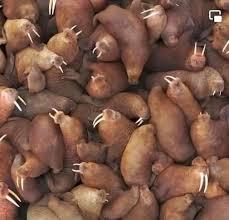
This was all news to me, though I was not surprised to find that research on female walruses and their desires is still regrettably lacking.
The curators also asked the internationally feted queer Sámi photographer Gjert Rognli to create “interventions” at the Polar Museum. I am a great fan of his magical, often eerily lit nature photography, but the small photographs in the booklet of objects he contributed to the Queering Polar History exhibit didn’t give me a good sense of either his personal art style or what exactly they offered the viewer in the museum. On the other hand, his interview with Hauan is moving and perceptive about his own vision of queer art and his role in a “double minority position—Sámi and queer.”
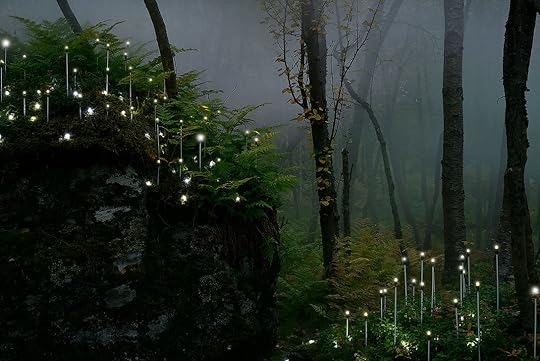 Gjert Rognli
Gjert Rognli
July 24, 2025
Save the Repparfjord!
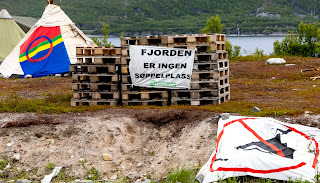 Protest site at Repparfjord, Norway, July 2025
Protest site at Repparfjord, Norway, July 2025This summer, on the site of a Canadian-financed copper mine on the mountain above the Repparfjord in Northern Norway, an encampment has gone up to protest the current construction and its ruinous consequences for Sámi reindeer grazing lands and the fjord near Hammerfest. You can read about the encampment here in a recent issue of the Barents Observer and see an Instagram video on the protest made by Ella Marie Hætta Isaksen, a young singer and activist affiliated with Norway’s environmental protection organization Natur og Ungdom (the youth movement of Friends of the Earth Norway). Ella Marie Hætta Isaksen asks everyone to write to the Canadian investment company Hartree to demand they stop funding this project, which is taking place without the consent of the Sámi parliament and many local Sámi in the area.
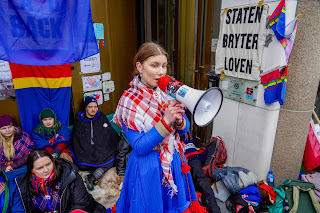 Ella Marie Hætta Isaksen
Ella Marie Hætta IsaksenFor more background on the project, read on:
The Repparfjord, or Riehppovuotna, is a National Salmon Fjord; the rivers that feed into the fjord from the mountains above are some of the world’s most pristine waterways, fished by the local Sámi for generations, and also beloved by fly fishermen from abroad. The fjord is a spawning ground for salmon, for cod, pollack, and other species. This marine environment was first threatened in the 1970s when the copper ore Nussir Mine in the mountains first came into operation with the promise of jobs for the nearby municipality of Kvalsund, a community of Sámi, Kven, and Norwegians located at the western end of the Repparfjord. Because of the falling price of copper, the open pit mine was only in existence from 1972-1978, but it was long enough for the company, Folldal Verk, to dispose of tailings (crushed rock, water, and trace amounts of metals or additives used in the processing) in the Repparfjord.
This was done without consulting the local population and the effects of the dumping were never monitored. But copper is now in great demand in the manufacture of electronics, and the amount of ore under the surface of two mountains above the Repparfjord, Ulveryggen (Gumpenjunni) and Steinfjellet (Nussir) is estimated at seventy-two million tons. Although Norway has a long history of copper mining farther south, in Røros and Løkken in the Trondelag area, the ore deposits around the Repparfjord are the largest known deposits in Norway. A renewed look at the Nussir brownfields began around 2005 with the establishment of an ASA (a public limited company), and some years of test drilling and raising money followed. The issue of what to do with the waste should mining be resumed was thoroughly discussed, but the plan was essentially the same as in the 1970s. The tailings would again spew into the Repparfjord, though this time the waste would flow through a pipeline from the plant to the fjord bottom. Dumping waste into waterways and the ocean has long been a human practice, but it’s a surprising fact that Norway is the only country in Europe and one of the last nation states to allow mining waste to be discarded in the ocean.
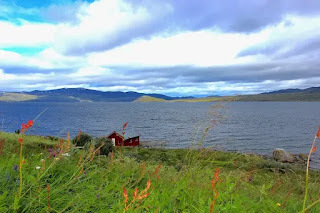 The Repparfjord
The RepparfjordThe mine was approved in 2019, with the goal of operating the world’s first fully electrified mine with zero CO2 emissions, but it has been bitterly fought ever since, with protests at the site driven by Sámi activists and other environmentalists. In 2020, the German company Aurubis, one of the world’s largest copper smelters, provisionally agreed to buy raw materials from Nussir ASA. A year later they terminated the memorandum of understanding after opposition, citing concerns about the effect on wildlife and the livelihoods of the Sámi in the area. The tailings were not the main issue; here it was the effect of the mine itself on local reindeer populations. Nussir ASA, in fighting for the mine, has insisted that the mitigation measures they propose will work, but most of those mitigation measures are on land. The Sámi Parliament, which in Norway is given the right of consultation but never the final say in any dispute over the environment, disagreed with Nussir ASA. The suggested mitigations were not sufficient.
There are conflicting ways of reading Norwegian laws and how they are to be interpreted with regard to Sámi rights. For instance, the Minerals Act of 2009 gives little agency to Sámi concerns, while the Natural Diversity Act, passed that same year, states that the purpose of the act “is to protect biological, geological and landscape diversity and ecological processes through conservation and sustainable use, and in such a way that the environment provides a basis for human activity, culture, health and well-being, now and in the future, including a basis for Sami culture.” There is currently a new Minerals Act, scheduled to go into effect in 2026, that speaks of “Extending the scope of the current special rules relating to Sámi interests to cover the entire traditional Sámi area.” But this revised Minerals Act is also focused on streamlining permits and encouraging production, in line with the EU’s Critical Raw Materials Act of 2024. What some critics, Sámi and non-Sámi, have noticed is how little say the Sámi Parliament has over the marine environment. While the rights of land-based reindeer herders are often threatened, there has been progress at times in finding compromises and/or limiting damage. But the rights of the traditional Sea Sámi to clean waters and a healthy marine ecology seem to be more nebulous when it comes to the law.
 Hammerfest protest against dumping in the fjord
Hammerfest protest against dumping in the fjordAlthough a number of people in the Kvalsund municipality are in favor of the mine because of the jobs involved and protests and continued pushback from the Sámi Parliament have slowed the process, the plans for the mine haven’t been given up. As of 2025, Blue Moon Metals of Canada is working with Nussir ASA to pursue mining operations. The Sámi Parliament President, Silje Karine Muotka, has been outspoken about the Nussir mine and about a “green shift” that depends on extractive processes that harm the environment and have an outsize effect on Indigenous populations in Norway. “It isn’t a question of economics, it’s a values question, a moral question about what we want to leave future generations. I do recognize that we need materials for new technologies – so we should look for better projects that don’t harm the environment and destroy our culture.”
 Sámi Parliament President, Silje Karine Muotka
Sámi Parliament President, Silje Karine MuotkaJuly 15, 2025
University of Minnesota Press Celebrates 100 Years of Publishing
Warm congratulations to the University of Minnesota Press, which is celebrating its founding July 16, 1925. Publishers Weekly has an article about the press that highlights some of its achievements and goals publishing both trade books and scholarly titles. I've read many of their titles over the years, everything from cookbooks to mysteries and natural history memoirs, and so many of them have been memorable.

I'm pleased and grateful that Minnesota has published a number of my own books, both translations and original titles, like From Lapland to Sápmi and The Palace of the Snow Queen. The people who work there are dedicated to quality, professional, collaborative, and truly kind, and I know I'm not the only author who feels blessed to be part of their list. The covers and interiors are always beautiful and the production details perfect.
Congrats Minnesota, for managing to thrive for a century in a publishing world that's so often challenging for independent and university presses!



